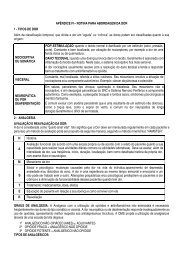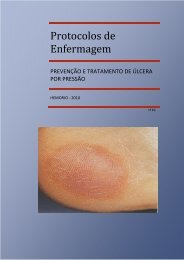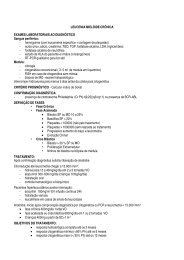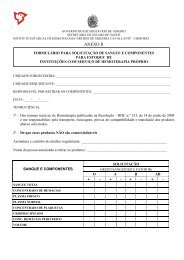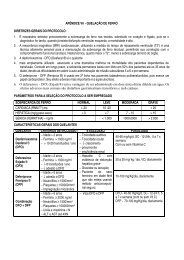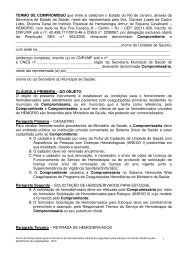Protocols - Hemorio
Protocols - Hemorio
Protocols - Hemorio
You also want an ePaper? Increase the reach of your titles
YUMPU automatically turns print PDFs into web optimized ePapers that Google loves.
TABLE – SUMMARY OF THE INDICATIONS<br />
Encephalic vascular accident, acute or intermittent episodes caused by infarct.<br />
The best results are obtained when the change is performed up to 6 hours<br />
CVA<br />
after the installation of the table. The purpose is to keep the HbS between 30<br />
and 50%.<br />
Acute Thoracic Syndrome – thoracic or abdominal pain, fever, pulmonary<br />
infiltrate to the radiological test, progressive respiratory failure, dispneia, PaO2<br />
ATS<br />
< 60 mmHg, kept for 6 months. The best results are obtained with the<br />
introduction of the Change Transfusion, as soon as ATS is established.<br />
Pulmonary<br />
In subjects with ECG presenting tricuspid regurgitation speed higher than 2.5<br />
hypertension<br />
or diagnosis of HP by other cardiopulmonary criteria.<br />
Execute the procedure in at most up to 12h, after the installation of the table,<br />
Priapism<br />
mainly if the HCT ≥ 20% of the baseline, in children or ≥ 25% in the adults.<br />
Refractory algic crisis Causing muscular necrosis with no-responsive pain to the drug in the 48h.<br />
Indicated in special cases that must be discussed jointly to the multidisciplinary<br />
Leg ulcer<br />
group. The Change Transfusion or hypertransfusion is indicated in the cases of<br />
concurrent hyperbaric treatment.<br />
History of multiple abortions, complications during the pregnancy and<br />
Pregnant women<br />
gemellary pregnancy.<br />
Surgeries Preparation for elective surgeries, of medium to big size.<br />
* The red blood cells to be transfused in this subjects must be de-leukocytated prophylactically and<br />
compatible for the antigens Rh and Kell (Rh1, Rh2, Rh3, Rh4, K1). Respect, whenever possible, the<br />
phenotype Jka and Jkb of the subject.<br />
* The regimen to be used at the change transfusion is described next:<br />
PROCEDURE OF CHANGE TRANSFUSION:<br />
1st - Check the subject’s weight<br />
- Vital Signs<br />
Step<br />
- Calculation of the total volemia (WEIGHT X 70)<br />
- Dosage of Hb or HCT of the unit(s) to be transfused<br />
2nd Step - Hydration – Fast step of 10 to 15 ml/Kg of SF to 0.9%<br />
3rd Step - Remove from 10 – 20% of the total volemia of the subject by step<br />
4th Step - Infuse around 5ml/Kg or 50% of the volume to be infused between the removals<br />
5th Step - Repeat the previous items until the volume to be removed is reached<br />
From 15% of removal of the total volemia from the subject, if it is necessary to keep the oncotic pressure<br />
of the subject, a human albumin may be used as a replacement liquid, and, in case of absence, plasma<br />
may be used.<br />
REMOVAL / INFUSION CALCULATION<br />
In general, 40 ml/Kg of weight are removed from the subject and transfused 30 ml/Kg. The purpose of the<br />
change is to keep the S hemoglobin between 30-50% until the next change procedure.<br />
If it is not possible, for any reason – particularly lack of a proper venous access – include the subject at the<br />
change regimen, you may choose the chronic simple transfusion regimen, being careful to make an<br />
adjuvant therapy with Iron chelant when the serum ferritin increases to more than 2,000 µg/dL.<br />
171



